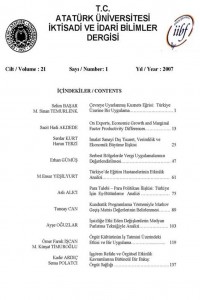Öz
Bu çalışmada, para talebinin yapısına ilişkin ampirik tahminlerin
para politikası tasarımındaki yeri dikkate alınarak Türkiye için para talebi
fonksiyonunun uzun dönemde istikrarlılığı 1987-2005 dönemi için kalıntıların
incelenmesine dayalı eş-bütünleme analizi tekniği kullanılarak test edilmiştir.
Türkiye’de esnek döviz kuru uygulamasına geçilmesinin ardından, para
politikasının ne şekilde uygulanacağı sorusu önemini korumuştur. Bu çerçevede,
özellikle finansal serbestleşme süreci ile birlikte para talebi ve para çarpanındaki
istikrarsızlık nedeniyle para politikası açısından parasal tabanının çapa olma
niteliğini kaybettiği konusunda çeşitli değerlendirmeler bulunmaktadır.
Çalışmada, eş-bütünleme analizinin ortaya koyduğu para talebinin
istikrarsızlığına ilişkin sonuçlar verilerek Merkez Bankası tarafından
uygulamasına başlanılan enflasyon hedeflemesinin Türkiye’de başarılı
olabilmesi için gerekli koşullar tartışılmakta, uygulamanın olası fayda ve riskleri
irdelenmektedir.
Anahtar Kelimeler
Kaynakça
- Alıcı, A., Ucal M. (2005), “Inflation Targeting Framework: Leading Indicator Variables of Inflation in Turkey”, Çukurova Universitesi Sosyal Bilimler Enstitüsü Dergisi, 14(1), 31-43.
- Ball. L.(1999), Policy Rules for Open Economies, ed. John Taylor, University of Chicago Press.
- Buch, C. M. (2001), “Money demand in Hungary and Poland", Applied Economics, 33(8), 989-999.
- Debelle, G., (1997), “Inflation Targeting in Practice”, IMF Working Paper, 97/35.
- Enders, W. (1985), Applied Econometric Time Series: Wiley Series in Probability and Mathematical Statistics, New York, John Wiley Inc., 358-377.
- Engle, R.F., C.W.J. Granger (1987), “Cointegration and Error-Correction: Representation, Estimation and Testing”, Econometrica, 55, 251-276.
- Granger,C.W.J.(1986), “Developments in the Study of Cointegrated Economic Variables, Oxford Bulletin of Economics and Statistics, 48, 213-228
- Halıcıoğlu, F., M. Uğur, (2005), “On Stability of the Demand for Money in a Developing OECD Country”, Global Business and Economic Review, 7(3).
- Johansen, S.(1988), “Statistical Analyses of Cointegration Vectors”, Journal of Economic Dynamics and Control,12, 231-254.
- Johansen, S., K. Juselıus (1990), “Maximum Likelihood Estimation and Inference on Cointegration with Applications to the Demand for Money”, Oxford Bulletin of Economics and Statistics, 52, 169-210.
- Karfakis, C. and Sidiropoulos, M. (2000) ‘On the Stability of the Long-run Money Demand in Greece’, Applied Economics Letters, 7(2), 83-86.
- Kasa, K., (2001), “Will Inflation Targeting Work in Developing Countries”, Federal Reserve Bank of San Francisco, 2001/1.
- Kongar, İ.Ç. (1995), “Cointegration Test for Money Demand – The Case for Turkey and Israel”, The Central Bank of the Republic of Turkey, Discussion Paper 9514.
- Kumhof, M., “Inflation Targeting under Imperfect Credibility”, Department of Economics Working Paper, Stanford University.
- Nelson, C. R. , C. Plosser (1982), “Trends and Random Walks in Macroeconomic Time Series: Some Evidence and Implications,” Journal of Monetary Economics, 10, 139-162.
- Philips, P. C. B., S. Ouliaris (1990), “Asymptotic Properties of Residual Based Tests for Cointegration” Econometrica, 578, 165-193.
- Pesaran, M. H., Pesaran, B. (1997), Microfit 4.0 Interactive Econometric Analysis, Oxford University Press, Oxford.
- Prodovinski, J.M. (1990), “Testing for a Misspecified Cointegrating Relationships”, Working Paper 19, Monash University, Australia.
- Sriram, S. S. (1999), “Demand for M2 in an Emerging-Market Economy: An Error Correction Model for Malaysia”, IMF working paper 99/173.
- Svensson, L.E.O., (2000), “Open-economy Inflation Targeting”, Journal of International Economics,50, 155-183.
- T.C. Merkez Bankası (2005), “Enflasyon Hedeflemesi Rejiminin Genel Çerçevesi ve 2006 Yılında Para ve Kur Politikası”, TCMB Basın Duyurusu, 2005/56 .
- Türkiye İktisat Kongresi, (2004), Fiyat İstikrarı Çalışma Grubu Raporu.
- Vega, J. L. (1998) “Money Demand Stability: Evidence from Spain”, Empirical Economics, 23(3), 387-400.
Öz
Kaynakça
- Alıcı, A., Ucal M. (2005), “Inflation Targeting Framework: Leading Indicator Variables of Inflation in Turkey”, Çukurova Universitesi Sosyal Bilimler Enstitüsü Dergisi, 14(1), 31-43.
- Ball. L.(1999), Policy Rules for Open Economies, ed. John Taylor, University of Chicago Press.
- Buch, C. M. (2001), “Money demand in Hungary and Poland", Applied Economics, 33(8), 989-999.
- Debelle, G., (1997), “Inflation Targeting in Practice”, IMF Working Paper, 97/35.
- Enders, W. (1985), Applied Econometric Time Series: Wiley Series in Probability and Mathematical Statistics, New York, John Wiley Inc., 358-377.
- Engle, R.F., C.W.J. Granger (1987), “Cointegration and Error-Correction: Representation, Estimation and Testing”, Econometrica, 55, 251-276.
- Granger,C.W.J.(1986), “Developments in the Study of Cointegrated Economic Variables, Oxford Bulletin of Economics and Statistics, 48, 213-228
- Halıcıoğlu, F., M. Uğur, (2005), “On Stability of the Demand for Money in a Developing OECD Country”, Global Business and Economic Review, 7(3).
- Johansen, S.(1988), “Statistical Analyses of Cointegration Vectors”, Journal of Economic Dynamics and Control,12, 231-254.
- Johansen, S., K. Juselıus (1990), “Maximum Likelihood Estimation and Inference on Cointegration with Applications to the Demand for Money”, Oxford Bulletin of Economics and Statistics, 52, 169-210.
- Karfakis, C. and Sidiropoulos, M. (2000) ‘On the Stability of the Long-run Money Demand in Greece’, Applied Economics Letters, 7(2), 83-86.
- Kasa, K., (2001), “Will Inflation Targeting Work in Developing Countries”, Federal Reserve Bank of San Francisco, 2001/1.
- Kongar, İ.Ç. (1995), “Cointegration Test for Money Demand – The Case for Turkey and Israel”, The Central Bank of the Republic of Turkey, Discussion Paper 9514.
- Kumhof, M., “Inflation Targeting under Imperfect Credibility”, Department of Economics Working Paper, Stanford University.
- Nelson, C. R. , C. Plosser (1982), “Trends and Random Walks in Macroeconomic Time Series: Some Evidence and Implications,” Journal of Monetary Economics, 10, 139-162.
- Philips, P. C. B., S. Ouliaris (1990), “Asymptotic Properties of Residual Based Tests for Cointegration” Econometrica, 578, 165-193.
- Pesaran, M. H., Pesaran, B. (1997), Microfit 4.0 Interactive Econometric Analysis, Oxford University Press, Oxford.
- Prodovinski, J.M. (1990), “Testing for a Misspecified Cointegrating Relationships”, Working Paper 19, Monash University, Australia.
- Sriram, S. S. (1999), “Demand for M2 in an Emerging-Market Economy: An Error Correction Model for Malaysia”, IMF working paper 99/173.
- Svensson, L.E.O., (2000), “Open-economy Inflation Targeting”, Journal of International Economics,50, 155-183.
- T.C. Merkez Bankası (2005), “Enflasyon Hedeflemesi Rejiminin Genel Çerçevesi ve 2006 Yılında Para ve Kur Politikası”, TCMB Basın Duyurusu, 2005/56 .
- Türkiye İktisat Kongresi, (2004), Fiyat İstikrarı Çalışma Grubu Raporu.
- Vega, J. L. (1998) “Money Demand Stability: Evidence from Spain”, Empirical Economics, 23(3), 387-400.
Ayrıntılar
| Birincil Dil | tr;en |
|---|---|
| Bölüm | Makaleler |
| Yazarlar | |
| Yayımlanma Tarihi | 27 Kasım 2010 |
| Yayımlandığı Sayı | Yıl 2007 Cilt: 21 Sayı: 1 |





